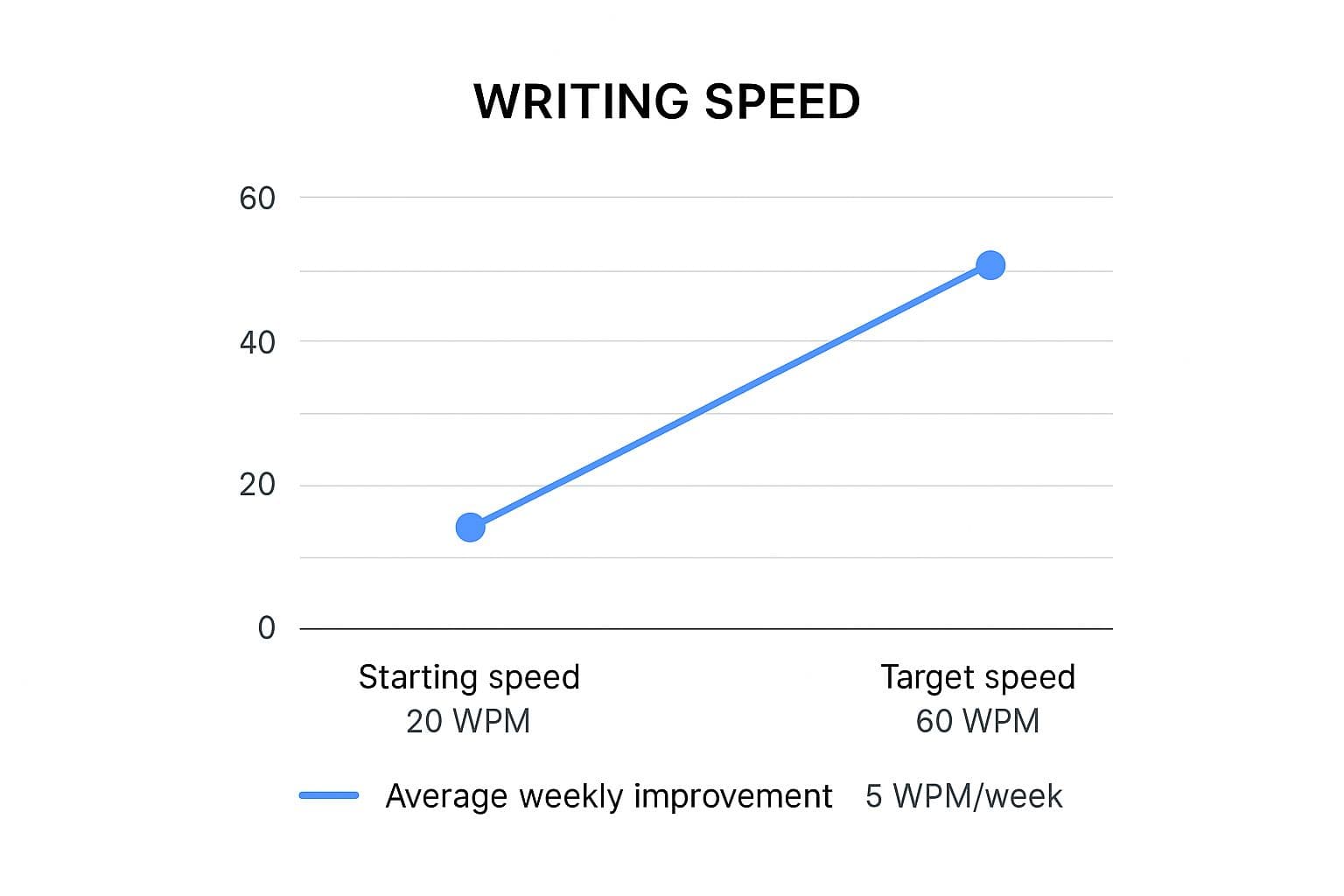How to Improve Writing Speed: Top Tips for Faster Writing
Discover how to improve writing speed with expert tips. Boost your productivity and write faster today by ditching perfectionism and using smart tools.

Want to write faster? First, you have to figure out what’s slowing you down. This isn't about generic tips you've heard a thousand times. It's about a personal diagnosis of your specific friction points—whether it's that paralyzing fear of the blank page or the constant urge to self-edit while you type. Identifying your personal roadblock is the first real step toward a faster, less stressful workflow.
Find the Real Cause of Your Slow Writing
Before you can hit the accelerator, you need to find the brakes. So many writers I've worked with just assume they're "slow" by nature, but I can tell you from experience: speed is a skill, not a fixed trait. The real culprits are usually hidden habits and mental hurdles that create drag and kill your momentum.
Think about the last time you sat down to write. Did you spend more time staring at that blinking cursor than actually typing? That’s a classic sign you're trying to nail every sentence perfectly on the first try. This kind of perfectionism is a huge bottleneck, turning what should be a fluid drafting process into a stop-and-start nightmare.
Another common speed killer is context-switching. If you're constantly jumping between your draft, a dozen research tabs, and your inbox, your brain never gets a chance to drop into a state of deep focus. Every single interruption forces you to re-engage, costing you precious minutes and mental energy.
Uncover Your Personal Roadblocks
The key is to figure out if your slowdown is rooted in your process or your psychology. It’s usually a mix of both.
- Process Issues: These are the mechanical problems with how you write. Think starting without an outline, getting lost down research rabbit holes, or not having your resources ready.
- Psychological Hurdles: These are the internal battles. We’re talking imposter syndrome, fear of judgment from clients or readers, or just that overwhelming feeling of staring at a blank document.
A major hurdle for almost every writer at some point is good old-fashioned writer's block. If that’s your main struggle, this guide on How to Overcome Writer's Block: Unlock Creative Flow has some fantastic strategies. Honestly, addressing these mental blocks is just as important as tweaking your workflow.
This chart really drives home how a little consistent effort can pay off, potentially tripling your writing speed over time.

As you can see, starting slow is completely normal. The real gains come from focused, consistent practice each week.
Common Writing Speed Killers and Their Solutions
To help you pinpoint your exact issue, I've put together this quick-reference table. It covers the most common obstacles I see and gives you an immediate action you can take to start fixing it.
| The Problem | Why It Slows You Down | The Quick Fix |
|---|---|---|
| Editing While Drafting | You switch from creative mode to critical mode, killing your flow and momentum before you have anything to work with. | Turn off your inner editor. Give yourself permission to write a messy first draft and fix it later. |
| No Clear Outline | You spend more time thinking about what to write next than actually writing, leading to detours and wasted effort. | Create a simple "skeleton" outline with just your main headings and a few bullet points for each section before you start. |
| Research Rabbit Holes | You get lost looking for "one more source," breaking your focus and derailing the writing session entirely. | Set a timer for research. Gather all your links and notes before you begin writing, then close those tabs. |
| Fear of the Blank Page | The pressure to produce something brilliant from scratch is paralyzing, leading to procrastination. | Start in the middle. Write the easiest section first to build momentum, or just "brain dump" messy ideas onto the page. |
Identifying and tackling these habits is the secret sauce. Once you know what's holding you back, you can apply the right strategy to break through the barrier and get your words flowing freely.
Build a Blueprint with Strategic Outlining
Ever find yourself just staring at that blinking cursor on a blank page? It’s a classic writer’s problem, but the real issue isn't the empty screen—it's showing up without a plan. An outline is your secret weapon, the blueprint that does all the hard thinking for you before you even start.
When it’s finally time to draft, you’re not wrestling with what to say. You’re just focused on how to say it.
Think about it like building a house. You wouldn’t just start nailing boards together and hope for the best, right? You'd need a detailed architectural plan. Your outline does the exact same thing for your writing. It gives you structure and a clear path from start to finish, so you never get stuck wondering what comes next. This one step alone can radically speed up your writing by getting all the decision-making out of the way first.
Move Beyond Basic Bullet Points
A truly powerful outline is way more than a simple list of topics. It’s a detailed map that gets inside your reader’s head and organizes your ideas in a way that just makes sense to them. I've found that many of the fastest writers I know use a question-based method to make sure their content hits the mark.
Before you type a single word of your draft, sketch out the key questions your audience is wrestling with.
- What’s the main problem they're trying to solve?
- What kind of solutions are they looking for?
- What do they need to know to believe your solution will work?
- What’s the one thing they should do next?
The answers to these questions become the very skeleton of your article. Each question turns into a major section, and your answers become the key points within it. This approach forces you to write from your reader’s point of view, which always results in more helpful and engaging content.
An outline's job isn't just to organize your ideas—it's to solve problems ahead of time. When you build a solid plan, you separate the "thinking" from the "writing." This lets you stay in that creative flow state when you actually start drafting.
See a Vague Idea Become a Plan
Let’s see how this works in practice. We can take a fuzzy idea and sharpen it into a plan that practically writes itself. Imagine your topic is "Healthy Eating for Busy Professionals."
Vague Idea: Write about eating healthy when you're busy.
Structured, Question-Based Outline:
- The Problem: Why is healthy eating so tough for busy professionals?
- No time for meal prep.
- Unhealthy takeout is just too easy.
- Brain is fried after work—too tired to make good choices.
- The Strategies: What are some dead-simple ways to make quick, healthy meals?
- Try batch cooking on the weekends.
- Have a go-to list of 5-ingredient, 15-minute recipes.
- Keep healthy grab-and-go snacks stocked up.
- The Proof: How does this actually save time and make you healthier?
- Share a sample weekly meal plan.
- Include a quick success story or testimonial.
- Highlight the time savings—maybe 3-4 hours a week.
- The Action: What’s the very first step they can take?
- Give them a downloadable grocery list for their first meal prep.
See the difference? This detailed blueprint turns a generic topic into a clear, helpful guide. The heavy lifting is already done. Now, your only job is to fill in the details.
This skill is invaluable, especially for more complex projects. If you’re tackling academic work, learning to structure information properly is a must. Checking out an ultimate research paper outline template is a great way to see how pros structure complex arguments, a skill that will speed up any kind of writing you do.
Adopt the "Draft Fast, Edit Slow" Mindset

If there's one habit that absolutely tanks writing speed, it's editing while you write. We’ve all been there. You type out a sentence, then immediately go back to tinker with it. And again. This constant stop-and-go is brutal on your momentum because it forces your brain to juggle two completely different jobs: creative flow and analytical critique.
The fix? It’s a game-changing mental shift. You need to strictly separate the fluid act of writing from the surgical act of editing.
Get comfortable with the idea of a "vomit draft" or a "shitty first draft." Seriously. Give yourself permission to just get words on the page without judging them. The only goal in this phase is to produce raw material. It doesn't have to be elegant, and it certainly doesn't need to be grammatically flawless. You just need something to work with.
Trying to write and edit at the same time is like trying to drive a car and fix the engine simultaneously. You won’t get very far, and the results are bound to be a mess.
Mute Your Inner Critic and Just Write
To really nail a fast draft, you need a few tricks to shut down that nagging inner editor. Timed writing sprints are perfect for this. We're not talking about a marathon session; the idea is to work in short, intense bursts of pure, unfiltered writing.
Here’s how I get it done:
- Embrace the Pomodoro Technique: I set a timer for 25 minutes and just write. No looking back, no fixing typos, just pushing forward until that timer dings. Then, I take a well-deserved five-minute break.
- Kill the Squiggly Lines: Those red and blue underlines from spell check are visual triggers that beg you to stop and edit. Turn them off. Out of sight, out of mind.
- Lean on Placeholders: If I'm missing a specific stat or can't remember a quote, I don't break my flow to go find it. I'll just drop in a quick note like
[TK-STAT-HERE]or[FIND-CLIENT-QUOTE]and keep on typing. I'll fill in the blanks when I'm editing later.
This will probably feel weird at first, especially if you’re a bit of a perfectionist. But trust me, once you feel the freedom of a true brain dump, you'll wonder how you ever wrote any other way.
A first draft isn’t supposed to be perfect; it’s supposed to be done. You can’t edit a blank page. Drafting fast gives you the clay. Editing is when you sculpt it.
Switch Hats and Become a Meticulous Editor
Once that messy first draft is down, walk away. I mean it. Give yourself a few hours, or even a full day if you can. This space is essential for what comes next.
When you come back, you’re no longer the writer. You're the editor. Approach the text with fresh, critical eyes. Now is the time to be ruthless. Sharpen your points, smooth out clunky sentences, verify your facts, and polish every last detail.
Because you have a complete draft in front of you, the editing becomes a much more focused and efficient task. You're not creating anymore—you're refining. Truly mastering this separation is a cornerstone of learning how to write faster and better without ever letting the quality slip.
Use Smart Tools to Speed Up Your Workflow

Let's be real: writing isn't just about pure, unadulterated creativity. A lot of it is a grind. But it doesn't have to be. The right tech can be a game-changer, acting as a true partner to help you get work done faster by smoothing out all those little bumps in the road that suck up your time and energy.
This isn’t about handing the keys over to a robot. It’s about being smart and using tools to multiply your own efforts. They can handle the boring, repetitive tasks, which frees you up to focus on what actually matters: your ideas, your strategy, and your unique voice. Your modern toolkit should be way more powerful than just a simple word processor.
Make AI Your Creative Sidekick
AI has completely changed the game for content creation, especially when it comes to speed. That terrifying blank page? You can now use AI to get a running start, so you're never starting from zero.
Tools like TypeBoost are brilliant because they integrate right into your existing process. You can highlight a clunky sentence, hit a keyboard shortcut, and instantly see it rephrased for clarity—all without ever leaving your document. It’s this kind of seamless help that really adds up and saves you a ton of time.
My take: AI tools are at their best when they're a launchpad, not a crutch. Use them to smash through writer's block, spitball five different headlines in ten seconds, or tweak a paragraph's tone on the fly.
Stuck trying to turn a dense interview transcript into a readable blog post? Instead of doing it all by hand, a tool can give you a solid first draft. To speed up that initial drafting process, you might want to check out an AI Blog Post Generator. It automates the most tedious part, letting you dive right into the fun stuff: editing and refining.
Build a Distraction-Free Writing Zone
Your digital space has a massive impact on your focus and speed. Let's face it, most apps are a nightmare of notifications, blinking cursors, and cluttered menus, all designed to pull your attention away from your actual work.
This is where distraction-free writing apps are a lifesaver. They’re built for one thing: getting you into a flow state. They strip away all the visual noise, leaving just you and your words on the screen. It’s like creating a peaceful little sanctuary just for writing.
Keep Your Research in One Place
Think about how much time you lose just flicking between your draft and a dozen browser tabs. Every time you switch, you lose momentum. It's a huge productivity killer.
This is an easy fix. Use a tool like Notion or Evernote as a central command center for your research. Before you even start writing, dump all your notes, links, and key stats into a single, dedicated document. That way, when you need to grab a fact or a quote, it’s right there—no more five-minute scavenger hunts. This simple habit keeps you locked in on writing.
Here’s an interesting thought: writing speed is a mix of what’s happening in your brain and what your fingers can do. Research has found that our raw cognitive processing speed actually peaks around age 18, while finger-tapping speed hits its max closer to 39 before slowly declining.
By using smart tools to handle the more mechanical parts of writing, you’re basically giving yourself a workaround. It lets you save your best brainpower for the creative stuff, no matter your age. You can dive deeper into these trends in this detailed study on processing speed.
Create Writing Habits That Actually Stick

Let's be real: genuine writing speed isn't about those manic, coffee-fueled all-nighters that leave you completely wiped out. It's about building a steady, sustainable pace with smart, consistent habits. From my experience, the most productive writers aren't just waiting for lightning to strike; they've built systems that make showing up to write feel almost second nature.
One of the most effective things you can do is create a simple pre-writing ritual. It doesn’t have to be complicated. It could be as simple as brewing a specific cup of tea, spending two minutes tidying your desk, and then opening your writing software.
This little routine acts as a psychological cue. It tells your brain, "Alright, it's time to get in the zone." Over time, this small habit dramatically cuts down on that awkward warm-up period, helping you slip into a state of flow much, much faster.
Ride Your Natural Energy Waves
Ever notice you're sharper and more creative at certain times of the day? That's not just in your head. It's your body's natural energy cycle, often called a chronotype, and learning to work with it is a massive unlock for your writing output.
Some of us are morning larks, ready to dive into the deep end of a project as soon as we wake up. Others are night owls, hitting our creative peak when everyone else is winding down. Trying to force yourself to be productive when your brain isn't cooperating is a one-way ticket to frustration and painfully slow progress.
The goal isn't to force yourself into a schedule that feels wrong. It's about aligning your most mentally demanding task—writing—with the hours you're naturally at your peak. You'll be amazed at how much more you can get done in less time.
This idea of natural rhythm influencing speed starts early. For example, research on handwriting development shows that 6th graders can write over 60 letters per minute, a huge jump from the 24 letters per minute managed by 2nd graders. It’s a great reminder that working with our natural progression is more effective than fighting against it. You can explore more about these developmental writing speed trends in this study.
The Power of Short, Consistent Bursts
When you're trying to write faster, it’s so tempting to block off huge, intimidating chunks of time on your calendar. But I’ll tell you a secret: consistency beats intensity every single time. Short, focused writing sessions done on a regular basis are far more powerful for building both speed and skill.
Here's why this method is so effective:
- It Builds Discipline: Committing to just 30-60 minutes a day feels manageable, which helps turn writing into a solid habit.
- It Prevents Burnout: Those marathon sessions can suck your creative well dry for days. Shorter sprints leave you feeling accomplished and energized for tomorrow.
- It Fosters Momentum: Getting a small win every day creates a positive feedback loop, making it easier to sit down and do it all over again.
By weaving these simple habits into your daily routine, you can shift from feeling like a slow, sporadic writer to someone who produces great work consistently and efficiently. For a deeper dive, check out our other guide on how to write more efficiently.
Got Questions About Writing Faster? We've Got Answers
Jumping into new writing habits can feel like a mix of excitement and "Where do I even start?" That's totally normal. Let's walk through some of the questions I hear all the time from writers trying to speed up their process without losing their minds (or their quality).
How Long Does It Really Take to See a Difference?
This is the big one, right? While there’s no universal timeline, most people start feeling a real shift in their workflow within a few weeks of consistent effort. Be warned, though: at first, things like detailed outlining or forcing yourself not to edit while you draft might feel like they’re slowing you down. That’s just the learning curve.
Once those habits click and become second nature, the payoff is huge. The secret is consistency over intensity. A solid 30-minute writing sprint every day will build momentum way more effectively than a marathon five-hour session once a week. Just stick with it, and you'll see your words-per-hour start to climb.
Can I Actually Write Faster Without My Quality Dropping?
Yes! It’s a common fear, but I’ve found that my quality actually improves when I focus on a smarter process. It sounds like a paradox, but it makes sense when you think about it.
When you split up the writing and editing phases, you give your creative brain the freedom to just get ideas onto the page. No judgment, no friction. Then, you can come back later with your editor hat on, ready to sharpen, cut, and polish. You’re no longer trying to do two conflicting things at once. The speed comes from working smarter, which leaves more mental energy for making the final piece great.
The goal isn't just about cranking out more words. It's about producing a better final draft in less time. Speed and quality aren't enemies; they're partners in a more efficient workflow.
I'm Overwhelmed. What's the Best First Step?
If you're looking at all this advice and your head is spinning, just pick one thing. The single most impactful change for most writers is embracing the "Draft Fast, Edit Slow" philosophy.
For your very next piece of writing, I challenge you to write a truly terrible first draft. Seriously. Turn off the spell-check, ignore typos, and just pour your thoughts onto the page. This one change can feel incredibly freeing and will instantly show you how much faster you can work when you’re not second-guessing every single word. Mastering this is a huge step to truly improve your writing skills for the long haul.
Should I Obsess Over Words Per Hour or Just Finish My Projects?
While metrics like words per hour can be a fun way to track progress, your main focus should always be on finishing the project. It's easy to get lost in the data, but what good is a 1,000-word-per-hour sprint if the draft is a dead end?
Instead, focus on process goals. Things like "finish the outline today" or "write the introduction." These smaller wins build the momentum you need to actually cross the finish line. As you nail down your process, you'll find that speed becomes a natural and happy side effect of having better habits.
Ready to eliminate the friction from your writing process? TypeBoost is a keyboard-first desktop app that lets you apply your custom AI prompts to any text, in any app. Stop copy-pasting and start rewriting, summarizing, and polishing your work with a single keystroke. Try it for free at https://www.typeboost.ai/en.